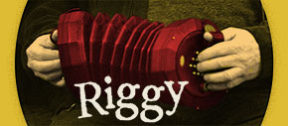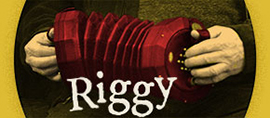
I’ve been playing English concertina since 1970. My old college classmate Chris Davala had seen Michael Cooney play one at a concert in Philadelphia and said, “Let’s get concertinas!,” and the race was on. We placed an ad in his suburban paper and got several responses. Every “concertina” turned out to be a button accordion, as people figured that if it didn’t have a piano keyboard it must be a concertina!
I went out to Milwaukee to visit my parents’ new home that Christmas and popped down to the Chicago Musicians Union music store and bought a cheap Bastari. I’d been playing guitar for quite a while at the time and simply “played guitar on the concertina,” playing by ear while staring at the fingering chart. The loop between chart, eyes, ears and fingers burned slowly into my brain over that Christmas vacation, and what I learned forms the basis of all I do on the box today.
After graduation I returned to Milwaukee to work in a record store that was going out of business. The “going out of business” part was central, because the deal between the clerks and the owner was that we could bring in our own personal albums we no longer listened to to trade for any of the stock. I got most of the catalog for Leader/Trailer, giving me the best traditional recordings of British Isles folk stuff. My favorite one was titled Northumberland Forever by the High Level Ranters. I was so delighted with that sound that I called my musical partner from my last year in Philly, fiddler John Specker, and invited him to tour England with me, with Newcastle-upon-Tyne as our destination.



We arrived in Newcastle on the morning of the day the Bridge Folk Club met, according to the liner notes on The Ranters recording. Showing total naivety, we went from the train station to the pub’s parking lot without a clue of what to do next. We took out our instruments and began to play our repertoire of American Old Timey music to no one. There was a stairway leading from the Bridge level down to the quayside along the river Tyne, and a potter who had a shop near the top liked what he heard and invited us in. We stayed the night with him and his lovely family. In the morning he mentioned that across the street there was a bagpipe museum in the Black Gate of the Castle of Newcastle, and that the new caretakers, Stefan and Liz Sobell, would be good people to meet. We went over and my life took a major turn.

At that time, I was only using guitar on stage and had purchased a very rare Martin C-1 shortly before leaving Philadelphia. It was unusual in that it had an extremely thin arched top, a round sound hole, a moveable bridge, and a golden tailpiece. Stefan immediately fell in love with this instrument.
He told me recently, “When I saw your Martin and said how lovely it was, you told me the guitar you had really loved was a Gibson that was stolen from you in London. Only when I realized you regarded the Martin as second best did I offer to buy it, and the incentive of the Wheatstone was enough to persuade you.”
He went on to become THE luthier for the hot celtoid bands of the ’70s, using my old C-1 as the template. Stefan tells the whole story here.


I went on to considering myself a concertina player.
That Wheatstone I got from Stefan was quite wonderful, but unfortunately it was stolen from the trunk of my car a few years later. I had a few good ones that served me well in the following years, but as I focused more and more on traditional Irish Music, I decided to switch to the anglo, diatonic system more associated with that genre.

After a while playing anglo, one of my mentors had a custom instrument made by Colin Dipper of Heytesbury, Wiltshire in England, with her own fingering system. I took her idea, surveyed other anglo players concerning their button lay-outs, and developed my own 40-button design which Colin executed for me in 1980.

That was the loudest acoustic instrument of any kind I’ve ever heard. I played it once for a group of carpenters working on a stone house in Colorado and they refused to believe it didn’t have amplifiers and speakers somewhere inside it! I could be part of a 12-person ceilidh band with five button accordions and you’d hear me over everyone else. When I moved to California it remained my main axe for ten years.
In the ’80s I became a resident of The Castle Folk Club by the invitation of Dick Holdstock. It was just like the traditional English folk clubs I’d experienced while living in the UK years earlier; a “select room” upstairs from the Edinburgh Castle Pub in the Tenderloin, where you’d buy your pints and fish ‘n’ chips downstairs and bring them up to enjoy with the music. And the music was vocal, rather than instrumental music.
Gradually I was brought back into the fold of quieter music, singing the traditional pub songs, and the English concertina. Eventually I arranged for Colin to make me another custom instrument, this time an English System and designed all the way down to the metallurgy to be a quiet, singer’s instrument. I arranged to pick it up in the fall of ’92 when I was attending Concertinas at Witney.

See article: “C & R Dipper” Concertina & Squeezebox, No. 28

In July of 2022 I flew to Maine to purchase this 1992 Dickinson Wheatstone Tenor in F.
Perfect l-o-w singer’s instrument.

